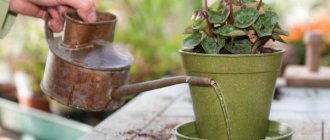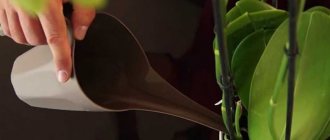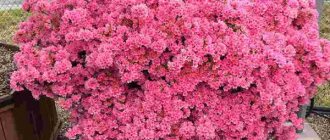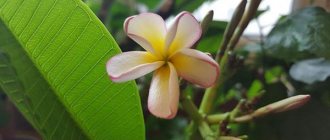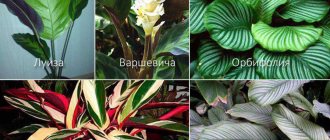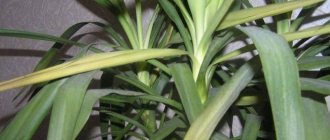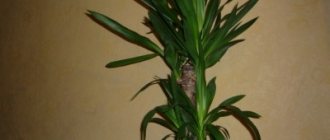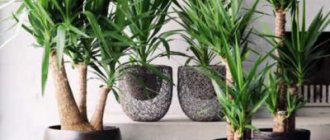Which question is the most important for those growing exotic plants at home? Of course, how to water yucca. It is this process, simple at first glance, that causes the most mistakes among novice gardeners. Some diligently moisten the soil, believing that this is better for the plant, others completely forget about irrigation, sincerely believing that the palm tree will survive without water. As a result, the exotic either rots or dries out. How not to destroy a flower? Let's figure it out.
With proper watering, yucca will delight you for many years
Yucca flower description. Photo
Yucca is not a palm tree, although it is very similar to it. Previously, the Yucca genus was classified as a member of the Liliaceae family. Now it is assigned to the agave family. It includes approximately 50 species. They grow wild in Mexico and the southern states of the USA. Yucca garden, like cacti, is an indispensable attribute of the landscape of the Mexican prairies. These are plants accustomed to arid climates and sandy rocky soils.
Their exotic appearance, reminiscent of a palm tree, is given by low-branched stems with plumes of long, sword-shaped leaves. It is to the green lush sheaves on high trunks that yuccas owe their other name - bunch-nosed plants.
The flowers are collected in tall, showy inflorescences. In preparation for flowering, the plant throws out from the center of the leaf rosette powerful, tall (up to two meters), spreading panicles of bell-shaped flowers up to 7 cm long, somewhat reminiscent of huge chestnut inflorescences. The yucca's long, serrated leaf ends in a sharp, single spine. The height of the yucca trunk can reach twelve meters.
There are also stemless varieties that form rosettes of leaves directly on the ground. On yucca trunks, scars from the petioles of dead leaves remain for a long time. The fruit of yucca is a juicy capsule (multi-seeded berry). The plant is pollinated exclusively by yucca moth. Therefore, when propagated in culture, artificial pollination is needed to set seeds.
Types for home cultivation
Caring for yucca at home is not difficult, but most breeders of this plant want to make it bloom, which rarely happens unless several mandatory rules are followed.
Yucca is valuable as a medicine. Its roots contain almost a daily dose of vitamin C, as well as a complex of women’s vitamins – A, E, folic acid. Minerals include potassium, calcium and others.
In South America, the plant is grown industrially to provide raw materials for the pharmaceutical industry. The only condition is not to consume it raw, since the plant tissue contains hydrocyanic acid.
Marginata aloelia
Yucca aloelia - Marginata - is distinguished by the presence of white stripes on the leaves, which are bent in the middle. This way the plant accumulates and retains moisture. The trunk rarely branches, so bushy specimens are practically never found.
Gray
Blue yucca comes from Mexico and is suitable for growing at home; with good care it can grow up to 2 meters in height. It does not grow quickly; usually an adult specimen is purchased and adapted to home conditions. It got its name because of the gray-blue color of the leaves.
Gloriosa
Compared to other species, Gloriosa does not grow tall - only up to 3 meters. It is better to plant in a room where it will grow slowly. There are species with green leaves and variegated ones - with white and yellow stripes.
Variety Pak
This variety was bred by Dutch breeders. There is no pattern on the leaves, and they themselves are not so dense and sharp, so they do not pose a danger in care.
Artola Gold
A species of giant elephant yucca. The difference is that there is a light green stripe running down the center of the leaf, turning into light green.
Yucca Schidigera
The plant is common in the US state of Nevada, brought from the desert. It has hard, dark green leaves. With age, the lower plates die and dry out. There are specimens in nature that are over 500 years old. It grows slowly. In the middle zone it takes root in warm climates.
Yucca at home care
Location
The natural habitat of yucca is characterized by a dry climate and rare but plentiful rains. In nature, yucca is accustomed to bright sun. Young plants are especially demanding of the sun. However, in the microclimate of an apartment, the plant feels uncomfortable in direct sunlight. The best location in the room is east or west windows.
Lighting
The optimal day length for yucca is 16 hours. When there is a shortage of sun, it is illuminated with fluorescent lamps. In summer, the plant benefits from fresh air and sunlight, subject to mandatory protection from dampness and rain. If the yucca spends the summer in a room, be sure to ensure daily ventilation of the room. In winter, the plant especially needs good lighting.
Temperature
In spring and summer, the best temperature for yucca is 20–25 °C. In hot weather it is not recommended to leave it in the open sun. The plant needs shading. To avoid overheating, place the container with yucca in the shade and spray it after cooling. The optimal temperature in winter is 8–12 °C.
Diseases
It happens that due to some inconsistencies in care, the yucca gets sick. Here are the main problems, why yucca gets sick and how to treat it.
- Yucca is turning yellow. When the lower leaves turn yellow and fall off, this is a normal natural process. But if all the foliage suddenly turns yellow, it’s probably due to an excessively hot climate - high temperatures and long-term direct sunlight.
- Yucca leaves curl and fall off. This is how the plant can react to lower temperatures. You should immediately turn up the heating in the room!
- Yucca leaves are drying up. The “root of evil” here is an acute lack of moisture, both in the soil and on the leaves.
- Spots on yucca leaves. Most likely, the light spots appeared due to sunburn.
- Yucca pests. Among them are spider mites, mealybugs, scale insects and whiteflies. You can recognize their presence not only by detecting the insects themselves, but also by some foreign things - cobwebs, growths, spots. It is recommended to destroy with insecticides.
Yucca in winter
In autumn and winter, yucca has a dormant period. During this season, for successful wintering, the air temperature should not exceed 8–12 °C. At this time of year, use only warm water for irrigation.
Elevated temperatures, as well as lack of light, have a bad effect on the condition of yucca. Growth of shoots is observed. They become thinner and longer. The leaves turn pale and lose their elasticity. The plant is weakening. This is a favorable moment for pests to appear.
Attention! If it is not possible to provide the yucca with a cool winter, the following must be done:
- In autumn, keep the plant outdoors as long as possible.
- Next spring, expose the plant to the wild as early as possible, providing it with a quiet, secluded place.
- In a protected place, yucca is able to withstand short-term frosts.
Possible pests
The appearance of pests on yucca occurs rarely and only in cases where the plant is not properly cared for. Pests for yucca are generally not dangerous, but in any case, you should get rid of them as soon as possible.
The most likely infection of yucca is with false scale insects, aphids, mealybugs or spider mites. The habitat of all these pests is leaves; they are easy to see with the naked eye. Leaves affected by pests behave in the same way as overdried leaves - they turn yellow and fall off.
Pest control is universal and includes the following stages:
- Mechanical removal of pests with a sponge soaked in a solution of laundry soap.
- Treating the plant with an insecticidal preparation . Any universal insecticide for indoor plants will do. Among the drugs available in the retail chain, the drug “Actellik” has gained the most confidence among flower growers, but any other drug will do, for example, “Fitoverm”, “Gaupsin” or “Bi-58 New”.
- Normalization of plant maintenance regime.
Watering the plant
Indoor yucca flowers do not like waterlogging. The frequency of watering depends on various factors: the size of the container, the size of the plant, the composition of the soil, etc. Yucca does not tolerate stagnation of water. In summer, it is watered generously, but only after a 5 cm thick layer of soil has dried. The main indicator of the need for watering is the condition of the soil in the pot. It should dry out. In winter, watering is kept to a minimum. Stagnation of water can cause yucca roots to rot and the plant itself to die.
Yucca reacts very sensitively to air humidity. It should be periodically sprayed with warm boiled water from a spray bottle.
This is interesting! If you run your finger along the edge of a yucca leaf, you can feel the cloves. Yucca drinks water with them. Absorbs moisture from the atmosphere. Therefore, you can spray it at least three times a day. With frequent spraying, yucca is rarely watered.
She herself shows when she needs watering. The top row of yucca leaves always faces upward. The lower ones are bent down. And the middle leaves are mobile - when the soil is wet, they are in a hanging position, and when it dries out, they rise and fold slightly “into a boat.” This is how the plant asks to drink.
To increase air humidity, place the pot with the plant on a tray with wet gravel or moss. To avoid burning the leaves, spraying is not carried out in bright sun.
Attention! To remove dust from a plant, it is enough to give it a warm shower every few months. To do this, you need to wrap the pot in a bag, covering the soil, slightly tilt the plant and use a spray bottle to wash it from all sides. The water may be hot, but not burn your hands.
Appearance
This plant may have a single or branched trunk. Yucca also differs from other plants in that the leaves cover not only the branches, but also the trunk. They are slightly elongated and form a pointed shape at the end. Throughout its life, yucca blooms very rarely. Its flowers are quite large and have a white tint. Many people associate them with bells because of their original shape. Many gardeners choose this plant not to enjoy their flowering, but to enjoy their unusual appearance. After all, yucca strongly resembles a miniature palm tree.
Feeding yucca
Yucca is fertilized during the active growing season, that is, in spring and summer with an aqueous solution of mineral fertilizers. The frequency of feeding is every two to three weeks. Yucca responds to the addition of organic matter with growth and a healthy appearance. Use humus or a diluted infusion of manure.
Non-root feeding with solutions of complex fertilizers is very effective. In this case, they try to spray the leaves from the underside. Feeding is contraindicated for sick yuccas. You should not fertilize them immediately after transplanting.
Features of care
Since yucca is undemanding, care at home comes down to timely watering, shaping and fertilizing. Even novice gardeners can cope with a tree-like plant.
How to water yucca
Irrigation of the false palm is carried out exclusively with warm, settled water; cold watering of the yucca causes stress. In summer, moisture should be plentiful, but it is necessary to ensure that the top layer of soil has time to dry out by 5-7 cm.
If the room has an optimal microclimate, then the frequency of watering is 1 time per week, where 1 liter of liquid is used per 5 liters of substrate. To avoid putrefactive processes in the root system, irrigation activities are reduced in the spring, autumn and winter seasons.
Feeding
Fertilizing a houseplant should begin in April and end at the end of August. Feed indoor yucca once every 2-3 weeks, using complex mineral formulations. It is best to do foliar feeding on the back side of the leaf blades.
How to prune yucca
To maintain the decorative qualities of a false palm tree, which is prone to branching, formation must be done correctly; it is recommended to trim the shoots at a certain time - before the start of active growing season (late winter - early spring). Since after cutting off the crown with leaves, all growth processes in the plant are suspended, it is advisable to perform the manipulation with a trunk thickness of 5 cm and a height of 60-70 cm.
The algorithm of actions boils down to:
- Trim the top of the yucca with a sharp, disinfected knife as high as possible from the soil surface.
- Processing a cut with crushed coal made along the entire diameter of the trunk. If you ignore this point, there is a high probability of rotting.
- Placing the flower crop in a well-lit place.
- Regular watering.
Leafless palm trees are irrigated 2 times a week. After 3-4 weeks, buds will begin to emerge near the cut. Their number is 2-5 pieces. Thanks to pruning yucca at home, you can rejuvenate and get new shoots. The cut top is often used to produce another plant; rooting occurs in moist soil.
Pests and diseases
If agricultural practices are violated in the process of caring for a palm tree, fungal diseases will appear:
- Leaf spotting. Brown spots form on the plant. In this case, it will be necessary to reduce the frequency of irrigation activities and reduce the humidity level. Contaminated parts should also be removed.
- Rotting of the trunk and root mass. As soon as signs of the disease have been detected, the affected parts of the indoor tree must be removed. Make watering moderate and reduce the humidity in the room.
Not only diseases can destroy yucca, but also parasitic insects:
- Spider mite. The pest settles on the underside of leaf blades; as a result of its activity, their color becomes dull, and ultimately they die. It is possible to prevent the appearance of the pest by treating the palm tree with a soap solution or insecticides.
- False shield. A parasitic individual poses a threat not only to the leaves, but also to the stems of the plant. If you do not fight it with insecticidal preparations, the ornamental crop will die.
Transfer
For better growth, young yucca is replanted annually in the spring (an older plant - as needed), each time slightly enlarging the pot. Yucca is a pot plant; in adulthood it will need a lot of space.
The timing of yucca transplantation is spring or summer. The container must be deep enough to accommodate a drainage layer of at least two centimeters. This could be gravel, pieces of brick, expanded clay.
You should not take a pot that is too large; the soil in such a pot usually turns sour. This is easy to determine - acidified soil smells unpleasant because it does not dry out for a long time. The plant develops poorly in such conditions, and the root system may rot.
Indoor yucca is undemanding when it comes to planting mixture, but prefers something that is breathable and at the same time nutritious. It would be useful to add a baking powder: vermiculite or perlite. The pot is chosen slightly wider than the root system. The plant should not be deeply buried; there should only be roots in the ground up to the root collar, and the above-ground part should be on the surface.
The substrate must have neutral acidity: pH 6.0–6.5. There are ready-made mixtures for palm trees in stores. When preparing the soil yourself, coarse sand is added to it up to one third of the total volume.
After replanting, you need to water the plant no earlier than the earthen ball has dried thoroughly; if it is wet, wait it out, especially in winter.
How to help a flooded yucca?
If you still overdid it and the yucca began to die, try to save it:
- Remove the flower along with the earthen lump from the pot. To do this, carefully tap the flowerpot around the perimeter.
- Remove rotted roots and treat the wounds with crushed activated carbon.
- Wrap the soil in old newspapers or towels.
If necessary, change the paper or fabric several times until all excess water is removed from the soil. Then plant the plant in the new potting mix.
Trimming
There are different purposes for pruning:
- achieve branching;
- reduce the height of the plant.
You need to know that after this operation the growth of the trunk in thickness will stop, so it is recommended to trim plants with a stem thickness of at least five centimeters. Pruning is carried out in February - March, before the start of active growth.
The instrument must be sharpened and disinfected. You can use a knife, pruning shears or garden saw. If the tops of the heads were sawed out, the sections after the operation should be cleaned with a sharp knife.
The plant must be healthy, at least thirty centimeters high. With a sharp instrument, a part of the top of his head, five to ten centimeters long, is cut off. When pruning, whether part of the leaves is left or not. In the second case, dormant buds awaken on the trunk. This happens after about three weeks.
The sections are sprinkled with crushed coal. Cuttings are used for propagation. For trimmed yucca, reduce watering to 1-2 times a week.
Does Yukka like spraying? What to spray to make the leaves shine?
Location Yucca should stand in the brightest place, even in bright sun, so especially in summer, take it out into the air. Watering From April to October, water moderately, and add liquid fertilizer to the watering water every 4 weeks. When the heat is intense, spray with water in the morning when it is in the shade. In autumn and winter, it needs about 10 C, although yucca tolerates 7 C; during the winter dormancy, keep watering to a minimum. Care Yucca is replanted every year in spring in good fertile soil. From November to March, stop feeding. Transplantation The species considered are among the most frost-resistant representatives of the genus. They are undemanding to soil and grow even on sand. Very drought resistant. Reproduction In February-March, yucca seeds are sown to a depth of 0.5 cm in moist soil. Then they are placed in a planting box, it is placed in the shade, maintaining a temperature of 21 C. When the seeds germinate, move them to a bright place. When they grow to 5 - 8 cm, usually after 3 months, transplant them into separate pots. If the plant has grown greatly, it can be propagated by cutting the stem into pieces at least 10 cm long in spring or summer. Treat the cuts with root and plant the pieces in the ground so that they stand straight. Cover with transparent film and place in a place protected from direct sunlight, maintaining a temperature of 24 - 27 C. The soil should always be moist. After three weeks, when the young shoots are sufficiently formed, remove the film and plant one or several pieces together in separate pots. Diseases With a lack of light, the lower leaves begin to lose their color. If overwatered, the plant wilts and grows poorly. If the yucca is attacked by the botrytis fungus and gray spots appear on its leaves, destroy the affected parts and spray the plant with an antifungal drug. If a mealybug infests, then white spots appear on the plant, and the brown scale leaves brown scales on the lower surface of the leaves and on the stems, so remove both with a soft cloth soaked in pure alcohol, or spray with a systemic insecticide.
Source
Yucca propagation
The methods of propagation of yucca are seed and vegetative.
Vegetatively
Yucca can be grown vegetatively:
- root suckers;
- stem cuttings;
- the tips of the shoots.
In the latter case, during rooting, the bulk of the leaves turn yellow and dry out.
Seeds
The substrate for sowing is based on:
- turf soil - 1 part;
- leaf soil - 1 part;
- sand - 1 part.
Sow in boxes or containers to a depth of half a centimeter, cover with transparent lids, plastic bags or glass. The crops must be ventilated every day, removing condensation from the transparent cover, and moistened.
Yucca sprouts within a month. Seedlings are picked when two leaves appear, planting the yucca in pots or cups with a diameter of 6 cm. After a week, the plant is fed at the rate of 1 gram of nitrophoska per 1 liter of water. The next year, the yuccas are placed in new pots measuring 8–9 cm.
Interesting! When propagated by seeds, variegated seedlings may appear.
Rooting the tops
It is carried out in stages:
- Using a sharp tool, cut off the top of the plant with several leaves.
- The sections are powdered with coal dust and left to dry for two hours.
- After this, the cutting is placed in water or wet sand.
To inhibit the development of putrefactive bacteria, two tablets of activated carbon are thrown into the water. During the rooting process, the yucca leaves rot. Rotten leaves are removed and the water is changed. The main thing is that the trunk does not rot. After root germination, the cuttings are planted in the substrate.
What to do after buying a plant
When purchasing a plant, check for obvious defects: rot, yellowed leaves, pests, and the like.
Yucca must be transported carefully, well packed in plastic film or wrapping paper. If the plant is damaged during transportation, it will need to be treated with crushed activated carbon .
Upon arrival home, place the plant in a cool place for half an hour without unpacking, after which you can proceed to replanting.
When transplanting, you must adhere to the following rules:
- It is not recommended to deepen the stem by more than 2 cm, because the root may rot.
- There is no need to compact the soil too much, as this can damage the yucca's root system.
- The upper border of the substrate must be 2–3 cm below the edges of the pot.
- After replanting, be sure to water the pot.
A ceramic or plastic pot for yucca is suitable. A special substrate is suitable for cultivation, including a mixture of turf, leaf soil, river sand and humus (2: 2: 2: 2: 1). Sand is replaced with perlite or vermiculite if necessary, which gives the substrate lightness and friability.
Common problems when growing yucca
The death of a plant in winter is usually due to two reasons:
- low temperature;
- excessive watering.
Too dry air causes the edges and tips of leaves to dry out and turn brown.
Insufficient watering and drafts can also cause brown spots on the leaves.
Softening and curling of the leaves, the appearance of brown spots is a signal to increase the temperature of the yucca. Particularly tender varieties droop and curl their leaves, even if they stand near a cold window at night.
Excess sun appears as light, dry spots on the leaf blades.
Diseases and pests. Why do the leaves turn yellow?
Yucca diseases
Cercospora blight. Brown spots of various shapes on the leaves. As the disease progresses, they increase in size and become lighter in the middle, remaining brown at the edges. Occurs due to excess moisture.
Control measures. Reducing watering and spraying. If the disease develops, treat with fungicides Fundazol or Topaz.
Brown spotting. The appearance of faded spots on old leaves. Over time, the spots first turn yellow, then brown. After four months, the black mushrooms themselves appear in the center. Often the spots are surrounded by a yellow halo. The disease appears from excess moisture.
Control measures. Limit spraying, especially in wet weather. Affected leaves are removed. Yucca is sprayed with Profit or Ridomil Gold.
Marginal necrosis of leaves. Dying of leaf edges. Usually affects old leaves. The dead fabric is gray-brown in color. Over time, the black fruiting bodies of the fungus appear.
Control measures. Reduce spraying. Affected leaves are destroyed. Yucca is sprayed with Ridomil Gold.
Fusarium. Signs of the disease: rotting of the bases of the leaves, leading to their death. The disease appears and develops with excessive dampness, in wet soil, and with the abuse of fertilizers.
Control measures. Competent agricultural technology. Treatment with Vitaros, Fundazol, Previkur.
White rot. Signs of the disease: damages all parts of the plant, but the lower leaves located near the ground are more often affected. They become discolored and a white coating appears. Appears sharply during sudden temperature changes and temperatures below 12–15℃
Control measures. Fungicides Rovral and Fundazol are used. Severely affected plants are destroyed.
Yucca pests
Spider mite. Usually spreads from the bottom of the leaves. The leaves become pale yellow in color. Whitish spots become visible on the upper side.
Control measures. Acaricides are used.
False shield. Placed on the leaves and trunks of yucca. The flower stops growing, the leaves dry out. Possible death of the plant.
Control measures. Spraying or wiping with Actellik solution (10 drops per 0.5 liters of water).
Problems and solutions
Yucca is an unpretentious plant, but even it is not immune from various diseases that arise due to improper care.
The “barometer needle” of the yucca is the leaves; from them you can immediately understand that something is wrong with the plant. A change in their shape or color should be alarming.
The plant as a whole has good resistance to diseases, the main thing is to prevent their aggravation. So:
- The leaves have turned yellow or brown spots have appeared on them - this is evidence of fungal infection of the leaves. The cause is excessive watering or air humidity. To prevent the fungus from spreading throughout the plant, the affected leaves must be removed, watering must be reduced and, if possible, the humidity in the room must be reduced.
- The leaves have become soft - a sign of excessive watering during the plant's dormant period. Normalizing watering will solve the problem.
- The leaves dry out at the edges - a sign of insufficient humidity or poor ventilation of the room.
- Curling and darkening of leaves - the air temperature in the room is too low for yucca. It is necessary to raise the temperature or move the plant to a warmer room.
- Light spots on the leaves indicate a violation of the lighting regime ; they appear when the plant is exposed to excessive sunlight.
- Yellowing and falling leaves are usually caused by the plant being in a draft or insufficient watering. However, you should not immediately start flooding the plant with water. You just have to make sure that the plant has enough of it. Such processes can also occur for natural reasons, but only with the lower leaves; the top should always have a healthy appearance.
Separately, you should consider possible problems with the lower part of the plant and roots. Sometimes, due to excessive watering and insufficient ventilation, the yucca stem begins to rot . This condition is considered very serious and requires immediate attention.
The plant can be saved by cleaning the stem from rot with a sharp knife and treating the cuts with crushed activated carbon or a fungicide. If putrefactive processes continue and a significant part of the plant is damaged, it will need to be destroyed along with the pot, since the infection can spread to other nearby indoor plants.
Types and varieties of yucca
The genus Yucca contains approximately thirty species. All of them grow in Central America. Sixteen species have been cultivated.
Yucca aloefolia . The plant has slightly branched stems with noticeable scars from dead leaves. Aloe yucca becomes palm-like with age. It grows slowly, reaching a height of 8 meters. Its trunk branches. The top of the branches is crowned with plumes of lanceolate leaves up to fifty centimeters long. The leaves are grooved, serrated along the edges, with a spine at the end.
Their weight may cause the trunks to become lodging. To prevent this from happening, the lower leaves are periodically removed. It blooms in summer with white bell-shaped flowers in large, branched inflorescences. Sometimes fruits are set - large, juicy, banana-shaped, green boxes with numerous black seeds. Yucca aloe vera is propagated with seeds, pieces of stems (30 cm) or plant tops. Prefers dry, drained soil.
Yucca fringe . A relatively low, slow-growing plant with a bright yellow stripe along the edge of the leaves. Doesn't bloom. Propagated by rooting crowns. Loves light and dry soil.
Yucca Karlsruisk . Obtained by hybridizing Yucca glaucosa and filamentous. It has no stem. Tufts of grayish leaves are densely arranged. Flowering is annual and abundant. The flowers are showy, large with wavy petals of a creamy color. The fruits do not set. Propagated by root suckers. Like all its relatives, it loves the sun and well-drained dry soils.
Yucca filamentosa . The rhizomatous form of yucca with closely spaced bunches of wide, drooping leaves, with threads peeling off at the edges. The flowers are white, placed on tall peduncles. Blooms in summer. Propagated by division. Tolerates shading. Loves dry fertile lands. Tolerates occasional waterlogging of the soil.
Yucca reflexifolia . A relatively small plant, shaped like a candelabra. The leaves are drooping and have a bluish tint. The inflorescences are low. The color of the flowers is white, large. Flowering period is summer. It reproduces by crowns and stolons growing at the base of the stems. Tolerates shading. Requires moderately moist soils.
Yucca drooping . This variety of yucca has virtually no trunk. Its leaves are bluish and drooping. The flowers are small, white, formed into lush inflorescences. Flowering time is early summer. The method of propagation is vegetative - by rosettes. Prefers dry soils and bright places.
Yucca bluish . Yucca bluish is often mistakenly called filamentous. This is a garden form with high frost resistance. It differs from filamentous yucca in the pubescence of the peduncle and narrower bluish-colored leaves.
Yucca is nice . A short-stemmed form of yucca with wavy sword-shaped leaves edged with a brown stripe. Low inflorescences contain up to 250 large greenish flowers. Spread with the tips of the shoots. Tolerant of shading, but becomes most decorative in the sun. Does not respond to temporary winter waterlogging of the soil.
Yucca Trekulya . Tall yucca with a thick trunk and hard short leaves. White flowers are collected in short inflorescences. Blooms infrequently. Propagated by rosettes. Requires fertile soil and full light.
Yucca grooveta . Natural polyploid. It is distinguished by powerful growth, large leaves, and branching. Tolerates shading. Reproduction is similar to other yuccas.
Yucca ivory . Can reach a height of eight meters. The trunk is thick at the bottom, near the ground, branched at the top. The leaves have a characteristic sword-shaped shape. Their length reaches one meter with a width of only five to eight centimeters. There are teeth along the edges of the leaves and a thorn at the top. White flowers up to eight centimeters long are located on a short peduncle.
Elephant Yucca Care
Lighting: sunny side. Temperature:
- in winter – not lower than 7 °C;
- in summer - 25 °C.
In summer, it is advisable to place yucca in the garden or on a sunny balcony. Full sun after the room is immediately contraindicated. To acclimatize, the yucca is kept in the shade for two weeks or protected from direct sunlight.
Substrate: any light sandy soil.
Transfer. At intervals of once every one to two years. Large plants are transplanted less frequently. If it is difficult due to the size of the tree, remove a five-centimeter thick layer of soil in the pot and replace it with a new one. Transplant time is spring.
Water abundantly, but rarely, only when the top layer of soil in the pot dries out. In winter, watering is careful and limited.
Nutrition: summer feeding.
Reproduction by seed or vegetative:
- “baby” sockets;
- the top of the plant, rooting it in the substrate.
The following garden forms are grown in culture:
- Gigantea - with larger leaves and flowers.
- Moogeapa - distinguished by a panicle inflorescence with many small flowers up to four centimeters long.
Indoor varieties of yucca plants with photos and names
What is yucca? This is a plant in which sword-shaped, half-meter-long leaves of small width are collected in a dense rosette. The bases of the leaves are wide, reaching up to 15 cm. A bluish coating on the dark green foliage adds elegance to the plant. The trunk is very pronounced, but the branching is rare. The natural growth of yucca is 3-5 m. Many have not seen how yucca blooms - we suggest: divine!
The yucca palm in the photo in nature is a gorgeous beauty
The main varieties are represented by Marginata, elephant yucca or giant, Tricolor, Quadricolor. Differences are noticeable in the color of the leaves and the size of the adult plant.
Variegated Filamentosa 'Bright Edge'
The varieties differ in the height and splendor of the inflorescences. The most common at home, giant yucca grows only one and a half meters in a few years.
INTERESTING!
Countries such as Guatemala and Mexico call yucca differently: Palmera and Palmita. However, although we commonly call this plant a palm tree, botanists will point out a mistake: yucca varieties have nothing to do with palm trees.
The so-called Palmita looks amazing in the Mexican wastelands.
The peduncle is amazing
The bluish spreading leaves of the Yucca Gloriosa variety make an excellent background for a large peduncle
Jewel is characterized by a dark green leaf edge
Yucca Aloifolia has short, wide, bright green leaves.
Catalog of indoor flowers with photos and their names. In a special publication on our portal we will talk in detail about indoor flowers. You will learn the types of indoor flowers, about fruit indoor flowers and get acquainted with the photo gallery.

